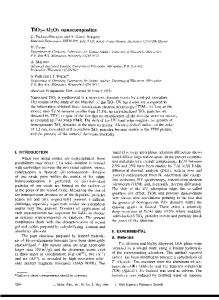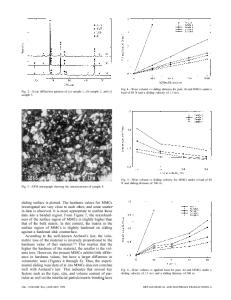Processing and Characterization of Al 2 O 3 and Al 2 O 3 / Cu Alloy Composites
- PDF / 284,105 Bytes
- 5 Pages / 612 x 792 pts (letter) Page_size
- 91 Downloads / 446 Views
Processing and Characterization of Al2O3 and Al2O3 / Cu Alloy Composites R.C. McCuiston, S.C. Danforth and D.E. Niesz Department of Ceramics and Materials Engineering Rutgers University Piscataway, NJ 08854, U.S.A. ABSTRACT Fused deposition of ceramics (FDC) has been used to fabricate macroscopically graded ceramic skeletons. These Al2O3 skeletons were subjected to binder removal and sintering treatments. The sintered skeletons were infiltrated with copper alloys. Both the skeletons and composites were characterized for micro and macrostructure using scanning electron microcopy. Potential applications for the macroscopically graded ceramic/metal composites focus primarily on impact. INTRODUCTION Fracture behavior and fragmentation control of materials subjected to impact events in such applications as turbine engine components and armor is of great interest. Turbine engine designers have to contend with damage to engine components from foreign objects like sand particles and stones, [1] as well as containing those components to avoid damage to the rest of the aircraft, in the event of a catastrophic failure [2]. The importance that fracture and fragmentation play in the ballistic performance of ceramic armor has been known for some time. Experiments in which ceramic tiles have been confined by metal, both laterally and hydrostatically, have shown improved performance in depth of penetration tests (DOP) over unconfined ceramic tiles [3]. For a projectile to penetrate a ceramic tile, fragmentation of the tile, initiated by fracture, followed by ejection of the fragments must occur [4]. By placing a confining pressure on the ceramic tile, fracture as well as ejection of fragments is reduced. The fragments are then able to contribute to the performance of the armor through erosion of the projectile. While confinement of the ceramic tile is beneficial, the actual application of such a confined armor system is difficult. When laid out in a single layer, such as appliqué armor on a vehicle, these confined armor systems would leave a network of unprotected areas around each ceramic tile in the form of confining metal. If a confining strategy is to be used, it is therefore necessary to provide another means. It has been shown with aluminum foams, that a topologically designed foam, in which the lattice is periodically arranged, has a higher shear modulus (G) for a given density, than that of a stochastic foam [5]. Extending the concept of purposely designed structures; metal fiber and random metal network reinforced ceramic composites have been shown to have improved properties over monolithic ceramics, chiefly fracture toughness [6]. This is due to metal ligaments in the composites bridging cracks and thus shielding the crack tip. The metal fiber reinforced ceramic composites however had the same fracture toughness as the random metal network composites, but at a lower volume of metal phase [7]. It is thought that a metal fiber reinforced ceramic, in which the placement of the reinforcing metal fibers is purposely designed
Data Loading...











